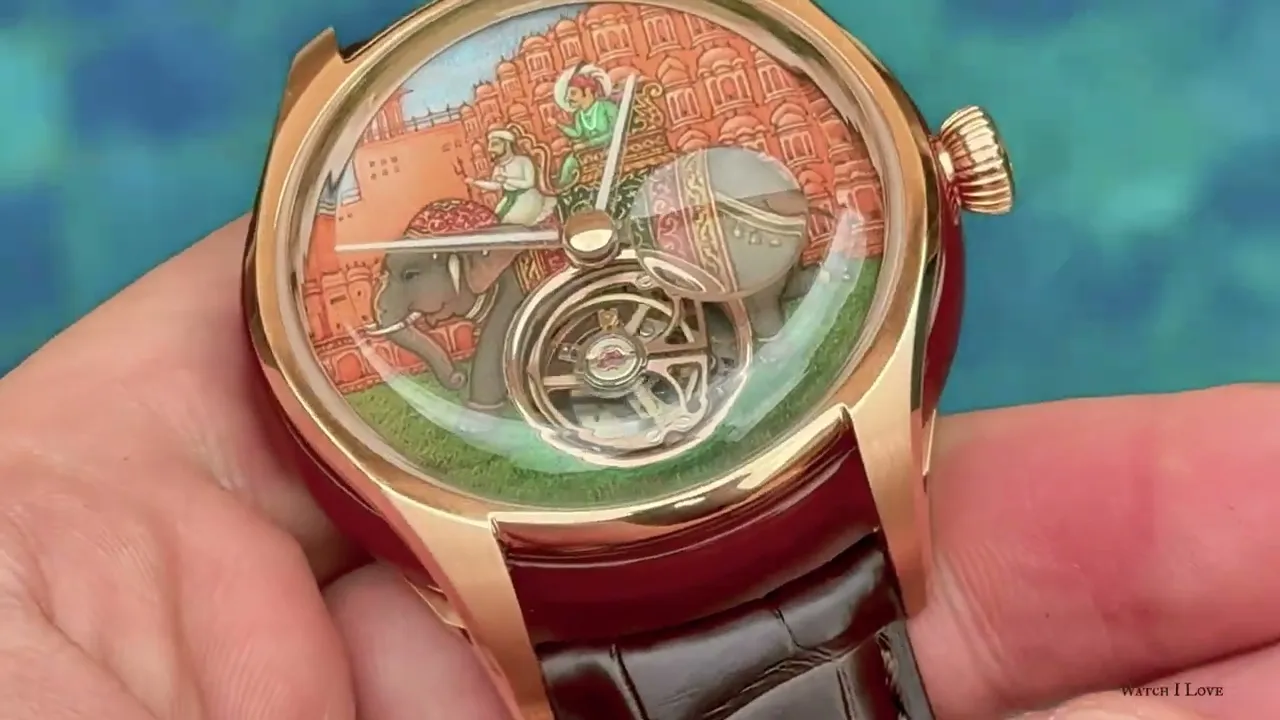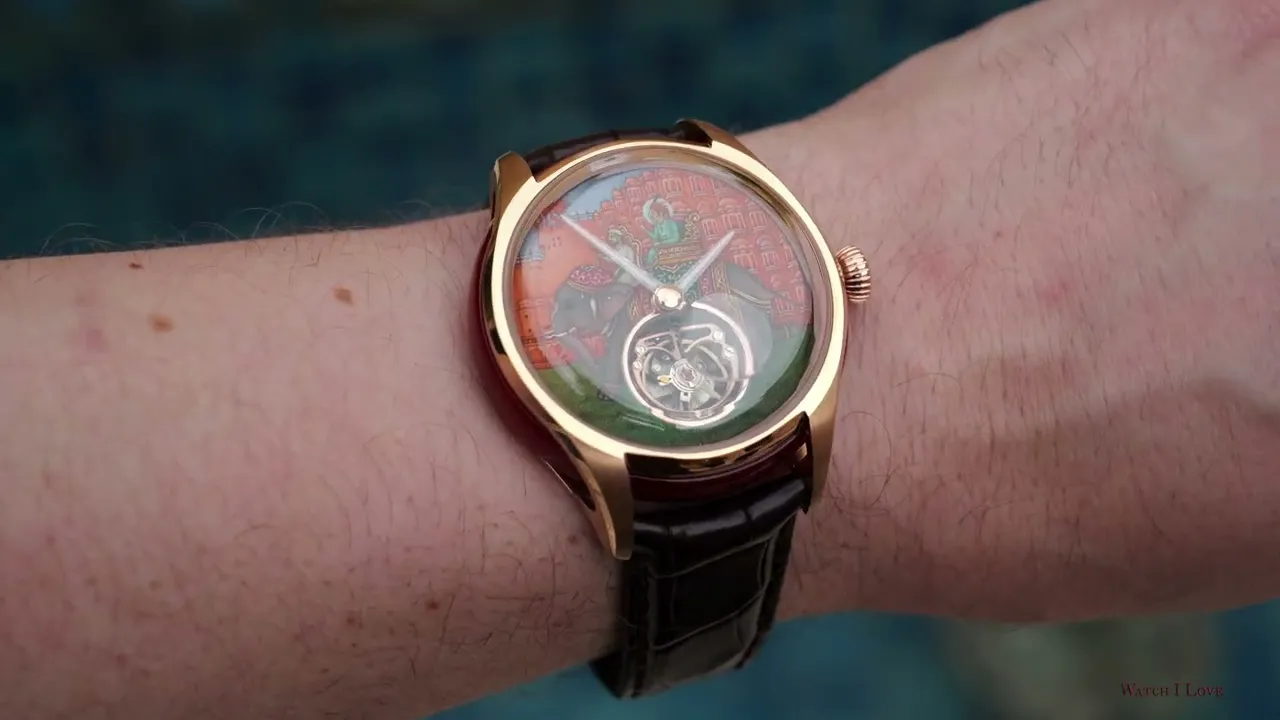In the rarefied air of haute horlogerie, the unveiling of Jalsa by Nebula, Titan’s 18K gold watchmaking house, ushers in an epochal moment for Indian watchmaking. This timepiece, conceived to honour the 225th anniversary of Jaipur’s Hawa Mahal, is not content to simply recount history; it embodies the very spirit of Indian artistry, architectural splendour, and the layered narrative of a civilisation where tradition and innovation have always danced in intricate tandem. Jalsa is not an artefact to be passively admired, but a vibrant celebration of the cultural and technical prowess that has defined India for centuries, now distilled into an object of wearable art.
Miniature Painting as Horological Poetry
To gaze upon the dial of Jalsa is to be transported into the heart of Jaipur, where the royal procession before the Hawa Mahal is immortalised in a tableau of astonishing delicacy. The dial is not painted upon a conventional canvas, but upon a slender disc of marble, barely 1.2mm thick, a nod to Rajasthan’s enduring legacy of stonework and its affinity for grandeur that is both robust and refined.

This choice of substrate is not accidental; marble, with its subtle lustre and resilience, provides the ideal medium for the natural gemstone pigments deployed by Padma Shri Shakir Ali, one of the last living exponents of Mughal and Persian-style miniature painting in India. The result is spectacular.

Ali’s mastery is evident in every brushstroke, each one painstakingly applied using techniques that have been handed down through generations. The pigments, derived from malachite, lapis, and even sindhoor, imbue the scene with a vibrancy that synthetic colours could never hope to achieve. The artist’s process, marked by relentless revision and an almost ascetic pursuit of perfection, ensures that every dial is unique, with subtle variations in shading and composition that render each piece a singular work of art. The secret pigment bond is guma arabica – a well known material but unexpected for me to be used in such a way for this work of art – I learned something new (besides many other things that will com on a later article).

The Rajput king astride his elephant, the attentive mahout, and the majestic Hawa Mahal rising in the background; all are rendered with a finesse that transcends mere representation, inviting the wearer to linger in the miniature world beneath the sapphire crystal.

A Technical Sonata in Gold and Jewels
Beneath the artistry of the dial beats the heart of a mechanical marvel: Titan’s in-house flying tourbillon, a complication that has long been the preserve of Europe’s most storied maisons. Comprising 144 precision-engineered components and 14 jewels, this movement is the product of years of research and refinement, brought to fruition by Indian watchmakers trained in the Swiss tradition. The tourbillon, positioned at six o’clock, rotates freely without an upper bridge, its motion a hypnotic counterpoint to the stillness of the painted scene above. A nice touch is the integration of “T” bridge design to pay an homage to the Titan watchmaking.

The movement is not content with mechanical virtuosity alone; it is adorned with architectural bridges inlaid with red agate, a gemstone that echoes the palette of the dial and the case, forging a visual continuity that is both subtle and profound. The hour and minute hands, milled from sapphire, float above the dial with ethereal grace.

The minute hand, in particular, is crowned with a miniature magnifying lens – a poetic flourish that allows the wearer to savour the minutiae of the artwork, while also presenting a formidable technical challenge in terms of torque balancing and precision. The movement, visible through a sapphire crystal exhibition caseback, is a sculptural composition in its own right, its interplay of polished and brushed surfaces, gold tones, and gemstone inlays offering a feast for the connoisseur’s eye.

We can notice a style that is unusual for traditional European watchmaking: while the movement development was realised with some Swiss experts, the Indian heritage put a strong fingerprint on the way the movement is presented. It is interesting to see the cohesive notes between dial, case and movement. The finishes are well executed showcasing the determination to create an excellent product.

Architecture Writ Small
Jalsa’s case is a masterclass in architectural watchmaking, eschewing traditional lugs in favour of a floating construction that sandwiches the marble dial between two sculptural layers of 18K rose gold. The case-middle is accented by a ring of natural red agate, a detail that required the testing of over 200 specimens to achieve the desired hue and translucency. This agate ring is not a mere embellishment; it serves as a visual and symbolic bridge between the world of Jaipur’s palatial architecture and the intimate scale of the wristwatch.

The case’s substantial weight of 68 grams speaks to the density of its materials, yet its proportions are carefully calibrated to ensure comfort and presence on the wrist. Every surface is meticulously polished and hand-finished, the interplay of curves and planes reflecting the light in a manner reminiscent of the Hawa Mahal’s own façade at sunrise. The sapphire crystal, both front and back, offers an uninterrupted view of the dial and movement, while the overall construction exudes a sense of solidity and refinement that is the hallmark of true luxury.
Indian Traditions: A Palimpsest of Culture in Gold and Stone
To wear Jalsa is to carry a fragment of India’s soul upon one’s wrist. The watch is suffused with references to the country’s artistic and architectural heritage: the marble dial recalls the splendour of Rajasthan’s palaces, the miniature painting invokes the centuries-old tradition of storytelling through art, and the use of natural pigments and gemstones anchors the piece in the earth from which it springs. The royal procession depicted on the dial is not a static vignette, but a living narrative, echoing the rhythms of Indian festivals and the enduring grandeur of its courts.

The flying tourbillon, with its relentless rotation, evokes the cyclical nature of time as understood in Indian philosophy, a reminder that beauty and innovation are not antithetical, but are instead two facets of the same creative impulse. Jalsa is a confluence of artistry and engineering, a watch that does not simply mark the hours, but elevates them into a celebration of heritage, ingenuity, and the quiet power of tradition reimagined for a global audience.

In sum, Jalsa by Nebula is not content to rest upon the laurels of its technical achievements or its aesthetic bravura. It is a horological palimpsest, inscribed with the stories, symbols, and aspirations of a nation that has always understood time as something to be cherished, adorned, and, above all, celebrated.

Jalsa Tourbillon by Nebula Technical Specifications
Model: Nebula by Titan JALSA Tourbillon
Special Features
- Edition Limited to 10 individually numbered pieces
- Each dial is unique, hand-painted; minute hand with magnifier; bridges inlaid with red agate
- Launch July 2025, official entry to GPHG 2025
- Price ₹40,50,000 / approx. CHF 37,600
Notable Details
- The dial is crafted from a single piece of marble, hand-painted using natural pigments such as lac, neel, turmeric, and gold, ensuring subtle variations and unique artistry for each piece.
- The movement, calibre 7TH2, is visible through the exhibition caseback and features nine distinct finishing techniques, including Geneva stripes and perlage.
- The case construction is complex, with a floating sandwich design and a distinctive ring of red agate, requiring the selection of over 200 specimens for the desired hue.
- The hour and minute hands are milled from sapphire crystal for transparency, and the minute hand is fitted with a sapphire magnifier to enhance appreciation of the miniature artwork.
- The watch is completed with a supple brown-tan leather strap, attached via hollowed lugs for comfort and seamless integration.
Movement
- Titan in-house flying tourbillon calibre 7TH2
- Movement type: Manual-winding mechanical
- Complications: Flying tourbillon at 6 o’clock
- Components: 144 parts, 14 jewels
- Movement decoration: Architectural bridges inlaid with red agate, Côtes de Genève, perlage, satin finishes, anglage
Case
- 18K rose gold, sandwich construction, case-middle encircled by natural red agate
- Case diameter 43.5 mm
- Case thickness Not officially specified; wears with notable presence on the wrist
- Case weight 68 grams
- Caseback: Sapphire crystal exhibition
- Crystal: Sapphire, front and back
- Strap: Brown-tan leather, seamlessly integrated
- Water Resistance: Not officially specified
Dial
- Hand-painted marble, miniature artwork by Padma Shri Syed Shakir Ali, natural gemstone pigments
- Hands: Sapphire crystal hour and minute hands, minute hand with sapphire crystal magnifier counterpoise
This technical profile reflects Nebula’s ambition to establish Indian craftsmanship within the global haute horlogerie arena, combining artistry, innovation, and a profound sense of cultural heritage.


















































